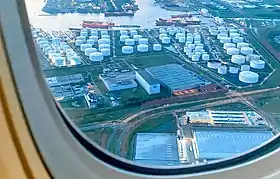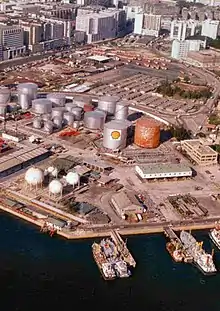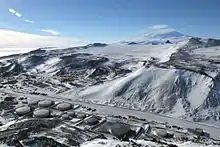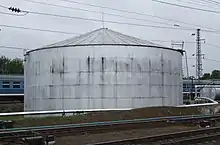Oil terminal
An oil terminal (also called a tank farm, tankfarm, oil installation or oil depot) is an industrial facility for the storage of oil, petroleum and petrochemical products, and from which these products are transported to end users or other storage facilities.[1] An oil terminal typically has a variety of above or below ground tankage; facilities for inter-tank transfer; pumping facilities; loading gantries for filling road tankers or barges; ship loading/unloading equipment at marine terminals; and pipeline connections.[1]



History

Originally, open pits and cubic reservoirs were used for industrial oil storage.
The vertical cylindrical steel reservoir structure was pioneered by Russian engineer Vladimir Shukhov during his work for Branobel oil company. He published an article "Mechanical structures in oil industry" ("Механические сооружения нефтяной промышленности") in 1883, mathematically proving that cylindrical shape would require the least amount of steel, modelling structural stresses specific to oil storage. Shukhov also developed construction methods, including tables that allowed to calculate required amount of steel and components depending on the reservoir size and type. By 1890, 130 vertical cylindrical reservoirs using Shukhov design were built in Russia.[2]
Location
Oil terminals may be located close to, or be part of, oil refineries; or be located in coastal locations where marine tankers can discharge or load cargo.[3] Some terminals are connected to pipelines from which they draw or discharge their products. Terminals can also be served by rail, barge and road tanker (sometimes known as "bridging"). Oil terminals are also located near cities from which road tankers transport products to petrol stations or other domestic, commercial or industrial users.[3]
Facilities
In most oil terminals there is no processing or other product transformation on site. The products from a refinery which are stored in the terminal are in their final form suitable for delivery to customers.[1] Blending of products may be undertaken, and additives may be injected into products, but there is usually no manufacturing plant on site. Modern terminals have a high degree of site automation.[4]
Marine oil terminals have jetties to provide a deep water mooring for tankers. Jetties have loading/unloading arms for transferring cargo to/from ship to shore. Facilities for vapor recovery may be provided.[5]
Some oil terminals receive crude oil production from offshore installations.[6] Crude oil received by pipeline may have been ‘spiked’ with natural gas liquids (NGL), and is known as live crude.[7] Such oil needs to be processed or stabilised to remove the lighter fractions such as ethane, propane and butane to produce a dead or stabilised crude that is suitable for storage and transport.[8] Such oil terminals may include processing facilities to treat the oil to achieve an oil Reid vapor pressure (RVP) of 10 to 12 psi (70 to 82 kPa).[9] The process facilities include oil heaters to warm the oil which then routed to separator vessels.[6] In the separators the lighter fractions flash off from the oil and are further processed to separate them into their individual components. The now stabilised oil can be routed to storage and then sold or sent for further processing.[6][9]
The storage tanks at an oil terminal may include fixed roof tanks, internal floating roof tanks[10] and external floating roof tanks.[1] Floating roof tanks are generally used for more volatile products to reduce evaporation loss. Fixed roof tanks have a vapor space above the product, which breathes in or out as the product is removed or the tank is filled. Some tanks may be fitted with internal heating coils using hot water or steam to keep the contents warm. This reduces the viscosity of the product to ease transfer and pumping. Terminals may also have ‘Horton spheres’ which are used to store liquefied petroleum gases such as propane and butane (see left foreground of the above Kowloon oil depot).
Standards
The design, construction, operation and maintenance of an oil terminal must be in accordance with local, national, regional and international codes, standards, and legal and statutory requirements. Relevant standards include:
- Safety Guidelines and Good Industry Practices for Oil Terminals, United Nations Economic Commission for Europe (ECE), 2013.[11]
- Environmental, Health, and Safety Guidelines for Crude Oil and Petroleum Product Terminals, World Bank Group (April 2007).[12]
- Design, Construction, Operation, Maintenance, and Inspection of Terminal and Tank Facilities, American Petroleum Institute, API STD 2610.[13]
- Guidance for Oil Terminal Operators, International Maritime Organization (IMO) International Ship and Port Facility Security (ISPS) Code (2003).[14]
- Tank Farm Guidelines for the Chemical Industry, Basle Chemical Industry (BCI, 2009).[15]
- OECD Guidance Concerning Chemical Safety in Port Areas (OCDE/GD(96)39), Organisation for Economic Co-operation and Development (OECD, 1996).[16]
- Design Code for Aboveground Atmospheric Storage Tanks, American Petroleum Institute, API 650.[17]
- Overfill Protection for Storage Tanks in Petroleum Facilities, American Petroleum Institute, API Recommended Practice 2350, 4th edition.[18]
- Prevention Of Tank Bottom Leakage - A Guide For The Design And Repair Of Foundations And Bottoms Of Vertical, Cylindrical, Steel Storage Tanks, EEMUA 183:2011, Engineering Equipment and Materials Users' Association (EEMUA, 2011).[19]
- Tank Inspection, Repair, Alteration, and Reconstruction, American Petroleum Institute, API standard 653, 4th edition, April 2009.[20]
- Functional safety - Safety instrumented systems for the process industry sector, International Society of Automation (September 2004).[4]
- Process Safety Management of Highly Hazardous Chemicals standard, 29 CFR 1910.119, Occupational Safety and Health Administration (OSHA, February 1992).[21]
- Safety Guidelines and Good Practices for Pipelines, ECE/CP.TEIA/2006/11, United Nations Economic Commission for Europe (December 2008).[22]
Health, safety and environment

Maintaining health, safety and environment (HSE) requires operators of a depot to ensure that products are safely stored and handled. There must be no leakages (etc.) which could damage the soil or the water table.[19]
Fire protection is a primary consideration, especially for the more flammable products such as petrol (gasoline) and Jet A1 aviation fuel.[23]
Incidents
The Buncefield incident occurred in December 2005. A petrol tank overflowed and spilt petrol down the outside of the tank which created a flammable fuel air mixture. This exploded and damaged and set fire to adjoining tanks and burnt for several days destroying much of the terminal.[24]
Ownership
The ownership of oil depots falls into three main categories:
- Single oil company ownership. When one company owns and operates a depot on its own behalf.
- Joint or consortium ownership, where two or more companies own a depot together and share its operating costs.
- Independent ownership, where a depot is owned not by an oil company but by a separate business which charges oil companies (and others) a fee to store and handle products. The Royal Vopak from the Netherlands is the largest independent terminal operator with 80 terminals in 30 countries.[25]
The owners may also provide "hospitality" or "pick up rights" at the facility to other companies.
Airports

Most airports also have their own dedicated oil depots (usually called "fuel farms") where aviation fuel (Jet A or 100LL) is stored prior to being discharged into aircraft fuel tanks. Fuel is transported from the depot to the aircraft either by road tanker or via a hydrant system.
See also
References
- "Oil Tanking - Tank storage and tank terminals". oiltanking.com. Retrieved 25 July 2020.
- "Стальное наследие инженера Шухова" [Steel legacy of engineer Shukhov]. Siberian oil (Сибирская нефть) (109). March 2014. Archived from the original on 2021-04-12.
- "Refineries, terminals and storage (UK)". Fueloilnews. Retrieved 25 July 2020.
- "Functional safety - Safety instrumented systems for the process industry sector". HSE. Retrieved 25 July 2020.
- Rahmanian, Nejat; Aqar, Dhia Y.; Bin Dainure, Muhammad F.; Mujtaba, Iqbal M. (2018). "Process simulation and assessment of crude oil stabilization unit". Asia-Pacific Journal of Chemical Engineering. 13 (4): e2219. doi:10.1002/apj.2219. hdl:10454/16518. S2CID 103139454.
- "Technical Information: processing storage and export". ineos.com. Retrieved 25 July 2020.
- "Crude Oil Sweetening and Stabilization". Arab oil and natural gas. 9 February 2017. Retrieved 25 July 2020.
- "Petropedia - Dead oil". petropedia. Retrieved 25 July 2020.
- Stewart, Maurice; Arnold, Ken (January 2009). "Chapter 2 - Crude Stabilization". Chapter 2 Crude stabilisation. Gulf Professional. pp. 81–106. doi:10.1016/B978-0-7506-8970-0.00002-5. ISBN 9780750689700. Retrieved 25 July 2020 – via Science Direct.
- "Internal floating roof tanks". engineers edge. Retrieved 25 July 2020.
- "Safety Guidelines and Good Industry Practices for Oil Terminals" (PDF). unece. Retrieved 25 July 2020.
- "Environmental, Health, and Safety Guidelines for Crude Oil and Petroleum Product Terminals" (PDF). World Bank. Retrieved 25 July 2020.
- "API Std 2610". API. Retrieved 25 July 2020.
- "Guidance for Oil Terminal Operators" (PDF). ocimf. Retrieved 25 July 2020.
- "Tank Farm Guidelines for the Chemical Industry".
- "OECD Guidance Concerning Chemical Safety in Port Areas". oecd. Retrieved 25 July 2020.
- "American Petroleum Institute, API 650" (PDF). API. Retrieved 25 July 2020.
- "API Recommended Practice 2350". standards.globalspec. Retrieved 25 July 2020.
- "Prevention Of Tank Bottom Leakage - A Guide For The Design And Repair Of Foundations And Bottoms Of Vertical, Cylindrical, Steel Storage Tanks". eemua. Retrieved 25 July 2020.
- "API standard 653" (PDF). API. Retrieved 25 July 2020.
- "Process Safety Management of Highly Hazardous Chemicals standard". osha. Retrieved 25 July 2020.
- "Safety Guidelines and Good Practices for Pipelines". unece. Retrieved 25 July 2020.
- "Storage tank protection" (PDF). Angus fire. Retrieved 25 July 2020.
- "Buncefield report". HSE. Retrieved 25 July 2020.
- "Vopak Tank Terminals". Archived from the original on 2007-07-28. Retrieved 2011-03-24.